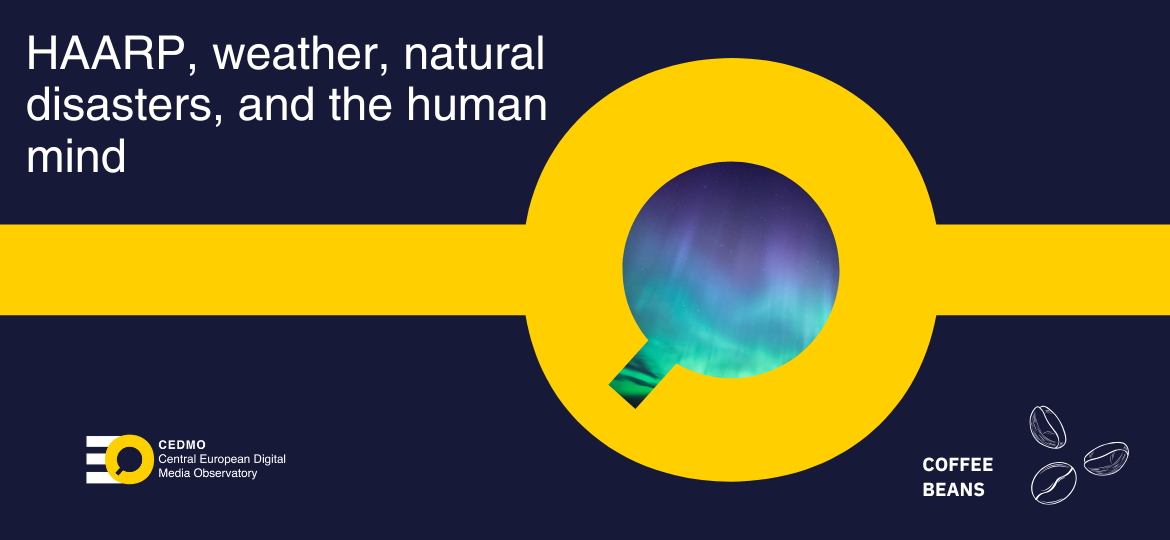
Prof. RNDr. Vanda Boštíková, Ph.D. Prof. RNDr. Aleš Macela, DrSc.
The HAARP (High Frequency Active Auroral Research Program) project, a scientific program focused on researching the behavior of the ionosphere (a layer of the atmosphere containing ionized particles), has sparked a wave of misinformation, misunderstanding, and controversy on social media, mainly due to its complex technology and military funding. For the general population, this gives the impression of a mysterious and potentially dangerous device. By reading (mis)information, we learn that this device controls the weather and is responsible for the formation of hurricanes, earthquakes, floods, or, conversely, droughts and fires. In reality, it is a scientific facility located near Gakona, Alaska, where the main instrument is the Ionospheric Research Instrument, consisting of a field of 180 radio antennas spread over an area of 0.13 square kilometers. These antennas are used to study phenomena occurring at altitudes of more than 50 kilometers above the Earth’s surface, where solar wind causes the ionization of atoms and molecules (resulting, for example, in the aurora borealis) (1,2).
Although it is only an advanced scientific project, it has sparked and continues to spark a number of conspiracy theories. Typical misinformation claims include speculation about HAARP’s ability to change the weather or be a “weapon of last resort,” an opinion expressed, for example, by Venezuelan President Chávez, who linked the project to the earthquake in Haiti (3,4). Another pseudo-theory claims that HAARP, when used for military purposes, can disrupt the Earth’s magnetic field, allowing harmful cosmic radiation to penetrate the surface. Some even believe that HAARP can deliberately influence the human mind using electromagnetic waves (5-7).
Emotional disinformation videos and photos are shared on Facebook and other platforms, claiming that HAARP is a secret military tool for geopolitical conspiracy or control of natural disasters – often in connection with current events on the Earth’s surface (disasters). Disinformation about HAARP is also fueled on social media by distrust of institutions and governments (7, 8).
Conspiracy theories are spreading on Czech social media claiming that Czech meteorological radars (Skalky or Brdy) are not just passive devices, but that thanks to special American systems, including HAARP, they directly “produce” weather and thus cause heavy rains and floods. These theories are supported by fake images of radar data with so-called concentric circles, which are, however, the result of technical measurement errors and not evidence of artificial weather manipulation. Another hoax claims that the government and meteorologists are covering up these acts and deliberately scaring people for political purposes. The Czech Hydrometeorological Institute and other specialists have repeatedly refuted any connection between radars and HAARP and weather patterns, pointing out that floods in the Czech Republic, for example, are a natural phenomenon caused by atmospheric pressure systems over Europe (8, 9).
The HAARP project, the equipment at its headquarters in a remote location in Alaska, the research methods and the purposes of the project are difficult for the general public to understand, which creates room for various conspiracy theories. Another factor is that the project was initially funded by the US Air Force and Navy, which also contributes to increased mistrust and a feeling of secrecy.
It is very difficult to counter nonsensical ideas. In this case, long-term education can be effective against demagogic claims. An example is Finland, which has a sophisticated education system where media and digital literacy are taught from an early age. The population is then better equipped to recognize false information. High-level mathematics and physics education contributes to people being better able to work with data, understand the principles of natural phenomena, and be less vulnerable to pseudoscientific conspiracy theories (8).
And finally, a note: the management of the University of Alaska, which oversees the HAARP project, has established a tradition of HAARP Open House days. Last year, the first such day took place in the first half of August. The visit includes an introductory presentation, a tour of the control building, a walk among the antennas, a workshop with experiments for both adults and children, and a discussion with scientists. Conspiracy theorists, if they are not afraid of being manipulated by electromagnetic waves, can thus view the HAARP facility in person and free of charge.
Literature
- Gordon W.E. HAARP facility in Alaska. Science, 1997, 275(5308), 1861-1865
- Singh S. The Technological Foudations, Applications, and Controversies Surrounding HAARP. Int J of Research Publication and Reviews, 2023, 4 (10), 3366-3372
- Encina C.G. Haiti:The US and Military Aid in Times of Natural Disaster (ARI). Madrid: Real Instituto Elcano, 2010
- Schuller M. Humanitarian aftershocks in Haiti. Rutgers University Press, 2016
- Deruelle F. Natural Disasters are Not All Natural. J of Geography, Environment and Earth Science Internat., 2023, 27(11), 74-94
- Smith N. Why conspiracy theories and misinformation spread in the long wait for Cyclone Alfred. The Conversation, 11.
- Smith J.E. HAARP: the Ultimate Weapon of the Conspiracy. Advantures Limited Press, 1998
- POKORNA v. Climate expertise and security politics: the case of the Czech republic. 2018. Climate expertise and security politics: the case of the Czech Republic | Digitální repozitář UK
- Vesely M. Thinking Climate, Framing Climate:Journalists and News Frames of Climate Change in Czech Media. Thinking Climate, Framing Climate: Journalists and News Frames of Climate Change in Czech Media
*This text has received support from the National Recovery Plan under project 1.4 CEDMO 1 – Z220312000000, Support for increasing the impact, innovation, and sustainability of CEDMO in the Czech Republic, which is financed by the EU Recovery and Resilience Facility.

